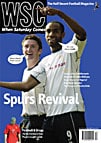 Mike Woitalla explores where it all went wrong
Mike Woitalla explores where it all went wrong
One must be careful, when sending out emails, not to hit the wrong button. Take a girls’ soccer coach in Wisconsin. This man claims he intended to send the pornographic video of himself to his girlfriend. Instead, the video arrived at the family email address of one of his teenage players and was opened by the girl’s mother. He ain’t coaching anymore. In April 2002, an official of the Women’s United Soccer Association (WUSA) made an electronic error of far less egregious proportions. It did, however, shed some light on women’s soccer in the US.
“We’re still getting a free pass from the media,” read the email intended for a friend. Instead, the message went out through his press-release address list, which reaches hundreds of sports journalists around the country. Oops.
Not that it affected the way in which the WUSA would be covered. The women’s league remained virtually immune to any media criticism until they announced they were folding five days before the US hosted the fourth Women’s World Cup in September.
There have been many reasons to celebrate the rise of girls’ and women’s soccer in the US. This country, which had historically encouraged boys to play and girls to dress in mini-skirts and cheer them on from the sidelines, has seen its sporting landscape transformed thanks to soccer. High schools and colleges without female soccer teams are anomalies. Women’s national team players became household names after winning the 1999 World Cup, the final of which attracted 90,185 to the Rose Bowl in California and 40 million TV viewers.
“I was intoxicated by what I saw at the 1999 Women’s World Cup and the sponsorships that were associated with that. I mistakenly assumed it would flow over into a league,” said John Hendricks, WUSA’s founder, when the league ceased operations after losing £60m in the first three seasons.When the WUSA official cited the press’s “free pass” early in the second season, the eight teams averaged around 5,000 fans per game.
Low television ratings didn’t deliver the demographic, teenage girls, that its investors, mainly cable TV companies, believed would yield a flood of advertisers. In its final season, the WUSA’s TV ratings were one 20th of what league officials had predicted. Then came the Women’s World Cup. The Americans fell in the semi-finals, 3-0 to Germany. After their 1999 victory, the US players became the first personalities to feature on the covers of People, Time, Newsweek and Sports Illustrated in one week. This time, there would be no major publicity boost for the women’s game. Media coverage isn’t to blame for the demise of WUSA or the failure of the US team. But the general reluctance to cast a critical eye on either has been a disservice.
The women’s national team have relied far too much on athleticism for their previous successes – World Cup titles in 1991 and 1999 and the 1996 Olympic gold medal. However, when the Yanks met a German team that matched them physically but brought more skill, their deficiencies were glaring.
The demise of the women’s league has been attributed to a variety of factors. Sponsors were blamed for not supporting the women’s sports cause. “At the high school and college level it’s more than an argument, it’s the law,” says David Carter, head of the Sports Business Group. “But guess what? Corporate America doesn’t owe sports a nickel. Broadcast outlets don’t owe them a look-see. Fans aren’t obligated to spend their money.”
Others say WUSA should have been marketed to teenagers and soccer dads, not preteens and soccer moms. The marketing budget should have been $10m, not $4m. WUSA failed because it relied on corporate investors, rather than individuals who can take losses without complaints from shareholders. These suggestions all have merit, and certainly WUSA suffered because it doesn’t have the support of the Latino population that has kept the men’s league afloat. But it has been taboo to question the quality of play – to ask whether WUSA teams were capable of entertaining in a way that would draw sports fans away from all their other options.
Women’s soccer’s incredible growth in the last decade belied the fact that it is still in its adolescence. The national team’s success has hidden the fact the nation does not yet have enough players with the skill, savvy and flair that can fill stadiums when national pride isn’t at stake.
From WSC 202 December 2003. What was happening this month